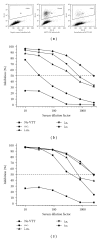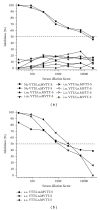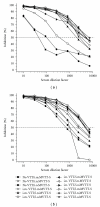Mucosal immunization induces a higher level of lasting neutralizing antibody response in mice by a replication-competent smallpox vaccine: vaccinia Tiantan strain
- PMID: 21765641
- PMCID: PMC3134386
- DOI: 10.1155/2011/970424
Mucosal immunization induces a higher level of lasting neutralizing antibody response in mice by a replication-competent smallpox vaccine: vaccinia Tiantan strain
Abstract
The possible bioterrorism threat using the variola virus, the causative agent of smallpox, has promoted us to further investigate the immunogenicity profiles of existing vaccines. Here, we study for the first time the immunogenicity profile of a replication-competent smallpox vaccine (vaccinia Tiantan, VTT strain) for inducing neutralizing antibodies (Nabs) through mucosal vaccination, which is noninvasive and has a critical implication for massive vaccination programs. Four different routes of vaccination were tested in parallel including intramuscular (i.m.), intranasal (i.n.), oral (i.o.), and subcutaneous (s.c.) inoculations in mice. We found that one time vaccination with an optimal dose of VTT was able to induce anti-VTT Nabs via each of the four routes. Higher levels of antiviral Nabs, however, were induced via the i.n. and i.o. inoculations when compared with the i.m. and s.c. routes. Moreover, the i.n. and i.o. vaccinations also induced higher sustained levels of Nabs overtime, which conferred better protections against homologous or alternating mucosal routes of viral challenges six months post vaccination. The VTT-induced immunity via all four routes, however, was partially effective against the intramuscular viral challenge. Our data have implications for understanding the potential application of mucosal smallpox vaccination and for developing VTT-based vaccines to overcome preexisting antivaccinia immunity.
Figures




Similar articles
-
One time intranasal vaccination with a modified vaccinia Tiantan strain MVTT(ZCI) protects animals against pathogenic viral challenge.Vaccine. 2010 Feb 25;28(9):2088-96. doi: 10.1016/j.vaccine.2009.12.038. Epub 2009 Dec 30. Vaccine. 2010. PMID: 20045097 Free PMC article.
-
A novel replication-competent vaccinia vector MVTT is superior to MVA for inducing high levels of neutralizing antibody via mucosal vaccination.PLoS One. 2009;4(1):e4180. doi: 10.1371/journal.pone.0004180. Epub 2009 Jan 13. PLoS One. 2009. PMID: 19159014 Free PMC article.
-
A novel high-throughput vaccinia virus neutralization assay and preexisting immunity in populations from different geographic regions in China.PLoS One. 2012;7(3):e33392. doi: 10.1371/journal.pone.0033392. Epub 2012 Mar 16. PLoS One. 2012. PMID: 22438922 Free PMC article.
-
The immunology of smallpox vaccines.Curr Opin Immunol. 2009 Jun;21(3):314-20. doi: 10.1016/j.coi.2009.04.004. Epub 2009 Jun 11. Curr Opin Immunol. 2009. PMID: 19524427 Free PMC article. Review.
-
Third-generation smallpox vaccines: challenges in the absence of clinical smallpox.Future Microbiol. 2010 Sep;5(9):1367-82. doi: 10.2217/fmb.10.98. Future Microbiol. 2010. PMID: 20860482 Review.
Cited by
-
Systemically administered DNA and fowlpox recombinants expressing four vaccinia virus genes although immunogenic do not protect mice against the highly pathogenic IHD-J vaccinia strain.Virus Res. 2013 Dec 26;178(2):374-82. doi: 10.1016/j.virusres.2013.09.016. Epub 2013 Sep 16. Virus Res. 2013. PMID: 24050999 Free PMC article.
-
Immunogenicity of a vaccinia virus-based severe acute respiratory syndrome coronavirus 2 vaccine candidate.Front Immunol. 2022 Jul 22;13:911164. doi: 10.3389/fimmu.2022.911164. eCollection 2022. Front Immunol. 2022. PMID: 35935962 Free PMC article.
-
Genomic sequence and virulence of clonal isolates of vaccinia virus Tiantan, the Chinese smallpox vaccine strain.PLoS One. 2013 Apr 12;8(4):e60557. doi: 10.1371/journal.pone.0060557. Print 2013. PLoS One. 2013. PMID: 23593246 Free PMC article.
-
The effects of post-exposure smallpox vaccination on clinical disease presentation: addressing the data gaps between historical epidemiology and modern surrogate model data.Vaccine. 2013 Oct 25;31(45):5192-201. doi: 10.1016/j.vaccine.2013.08.039. Epub 2013 Aug 27. Vaccine. 2013. PMID: 23994378 Free PMC article. Review.
-
Single-dose replicating poxvirus vector-based RBD vaccine drives robust humoral and T cell immune response against SARS-CoV-2 infection.Mol Ther. 2022 May 4;30(5):1885-1896. doi: 10.1016/j.ymthe.2021.10.008. Epub 2021 Oct 20. Mol Ther. 2022. PMID: 34687845 Free PMC article.
References
-
- Fulginiti VA, Papier A, Lane JM, Neff JM, Henderson DA. Smallpox vaccination: a review, part II. Adverse events. Clinical Infectious Diseases. 2003;37(2):251–271. - PubMed
-
- Nafziger SD. Smallpox. Critical Care Clinics. 2005;21(4):739–746. - PubMed
-
- Henderson DA. The eradication of smallpox. Scientific American. 1976;235(4):25–33. - PubMed
-
- Sauri MA, Frelinger JA, Garba ML, Belshe RB, Frey SE. Responses to smallpox vaccine. The New England Journal of Medicine. 2002;347(9):689–690. - PubMed
Publication types
MeSH terms
Substances
LinkOut - more resources
Full Text Sources
Medical
